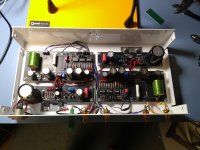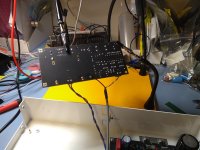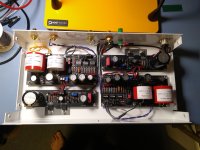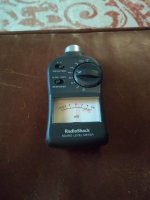I replaced the Vishay 1839HQs with ClarityCap CMRs.



Doesn't sounds worse - I did capture two separate 96kHz/24bit recordings of the same LP with the Vishays to compare to the ClarityCaps to see if I can spot any differences with DeltaWave Audio Null Comparator (free software) that computes the "distance" between two samples and also allows for ABX comparison.
- I did capture two separate 96kHz/24bit recordings of the same LP with the Vishays to compare to the ClarityCaps to see if I can spot any differences with DeltaWave Audio Null Comparator (free software) that computes the "distance" between two samples and also allows for ABX comparison.



Doesn't sounds worse
Last edited:
Yes it does, the Vishays were just anemic looking.It looks better no doubt
All kidding aside, well designed and well executed simple circuits with quality components seem to be the key. The UFSP sounds terrific.
I've noticed since I've been using the UFSP and the Mezmerize inner groove distortion, especially on vocals, seems to be less annoying.
Happy to know that UFSP + DCB1 married well in your system. Not easy to combine a 300mV phono source with a times one gain buffer preamp without significant loss of dynamis. Good for background noise though. Keys for DCB1's velvety neutral merits to unfold in a still satisfactory dynamic envelope are your sensitive tube amp and very sensitive vintage horn speakers of course. You had a winning strategy. Congrats.
Happy to know that UFSP + DCB1 married well in your system. Not easy to combine a 300mV phono source with a times one gain buffer preamp without significant loss of dynamis. Good for background noise though. Keys for DCB1's velvety neutral merits to unfold in a still satisfactory dynamic envelope are your sensitive tube amp and very sensitive vintage horn speakers of course. You had a winning strategy. Congrats.
Thanks Salas! You are completely right - It is a little wild that all the amplification from a 300uV MC cartridge to the speakers is done with just a few simple gain devices but is ~88 dB of voltage gain. There are few places to hide.
It is a little wild that all the amplification from a 300uV MC cartridge to the speakers is done with just a few simple gain devices but is ~88 dB of voltage gain. There are few places to hide.
I have a similar setup, FSP (pre-Ultra version) + Mezmerize B1, into self-powered speakers (Linkwitz Pluto II). I think the speakers have about 26dB nominal voltage gain @1KHz (and much EQ so considerably more at low frequencies). I have never felt a lack of dynamics, but volume control is usually about 1:00 o'clock position for "normal" listening. I am very happy with the result.
I have a similar setup, FSP (pre-Ultra version) + Mezmerize B1, into self-powered speakers (Linkwitz Pluto II). I think the speakers have about 26dB nominal voltage gain @1KHz (and much EQ so considerably more at low frequencies). I have never felt a lack of dynamics, but volume control is usually about 1:00 o'clock position for "normal" listening. I am very happy with the result.
Smart speakers from a smart man.
nezbleu - sounds like a great setup and I agree I don't believe I've had any dynamic limitations other than my ears. I can sustain 100dB spl at my listening position (definitely not recommended)

I did the DeltaWave comparison between samples of the same LP with the Vishay and Clarity, in short there seems to be a measurable difference . I took ~2minutes from the opening track on George Winston's Autumn (piano solo) album and captured it twice with the Vishay's in the UFSP and then captured it with the Clarity CMRs in place. I inverted one channel and summed to mono, idea was to capture just the stereo difference which should have the spatial cues. I compared the two Vishay samples and got a 28.7 dB null, when I compared the Clarity sample to the Vishay samples I got a 23.4 dB and 22.5 dB null. I don't think this is conclusive but it is interesting and I'll start a new thread to explore it further unless Salas wants to keep it here.
. I took ~2minutes from the opening track on George Winston's Autumn (piano solo) album and captured it twice with the Vishay's in the UFSP and then captured it with the Clarity CMRs in place. I inverted one channel and summed to mono, idea was to capture just the stereo difference which should have the spatial cues. I compared the two Vishay samples and got a 28.7 dB null, when I compared the Clarity sample to the Vishay samples I got a 23.4 dB and 22.5 dB null. I don't think this is conclusive but it is interesting and I'll start a new thread to explore it further unless Salas wants to keep it here.

I did the DeltaWave comparison between samples of the same LP with the Vishay and Clarity, in short there seems to be a measurable difference
Last edited:
BTW I think the recordings should be made after same warm up time for the electronics. But also after same cartridge play time. Since both the JFETs and cantilever suspension take time to warm up or exercise before better settling. Comparable room temperature is also key, especially for the rubber suspension's performance. Little differences in methodology can differentiate your null.
Very good point. I've done some more experimenting with DeltaWave this morning and I'm not convinced that my first blush results are valid  . I listened to the clips with headphones and I can't tell a difference but I noticed a lot of surface noise which appears to be accentuated by the invert-mono process. It also seems that the mechanical variations in playback (wow-flutter, etc) may be swamping the results.
. I listened to the clips with headphones and I can't tell a difference but I noticed a lot of surface noise which appears to be accentuated by the invert-mono process. It also seems that the mechanical variations in playback (wow-flutter, etc) may be swamping the results.
I think the way to really analyze this would be to use an inverse-RIAA/attenuator board at the input and feed it with DAC.
I think the way to really analyze this would be to use an inverse-RIAA/attenuator board at the input and feed it with DAC.
nezbleu - sounds like a great setup and I agree I don't believe I've had any dynamic limitations other than my ears. I can sustain 100dB spl at my listening position (definitely not recommended)
Thanks. It is very satisfying to me that my vinyl playback system is almost completely DIY. Turntable is an old Thorens TD-160 which I have heavily modified (still a few things to do), plus FSP, Mezmerize DCB1, and the Pluto's. Not much I can do about the phono cartridge.
The TD-160 is a classic! Some pictures of your setup would be delightful. DIY is great and there are even a few brave ones who tinkerer with cartridge work but usually it's parts and pieces from other cartridges - I think the suspension/cantilever/stylus are where most the character happens.
My fool's errand into measurement abyss made me realize the more I measured the less I enjoyed. Vinyl doesn't comply to uniformity, every playback is a performance peppered with nuance - that may be part of what makes it captivating.
Happy New Year
My fool's errand into measurement abyss made me realize the more I measured the less I enjoyed. Vinyl doesn't comply to uniformity, every playback is a performance peppered with nuance - that may be part of what makes it captivating.
Happy New Year
R15/C7 node (you refer to an old phono schematic, right?) should have much lower voltage than B+ rail due to R15 drops a lot via the Idss mA passing to Q7. Lower your rail to 33-34V for better TP and check Q7 on the lightly dropping channel. In any case in any version schematic if a voltage is odd in an RC node look to which JFET the current goes through the resistor value there. It does not pull correctly when the voltage is odd.
- Home
- Source & Line
- Analogue Source
- Simplistic NJFET RIAA